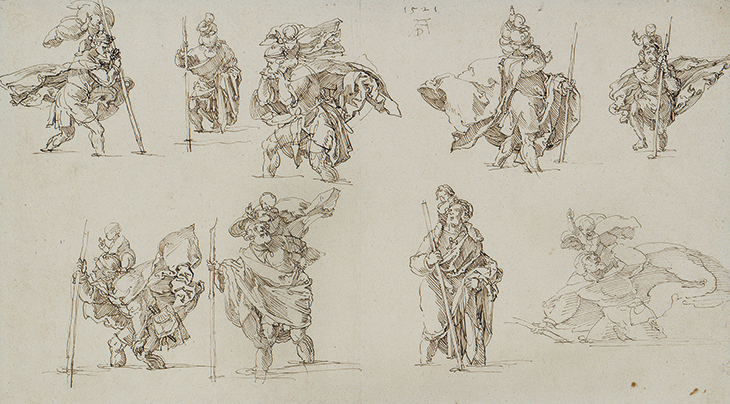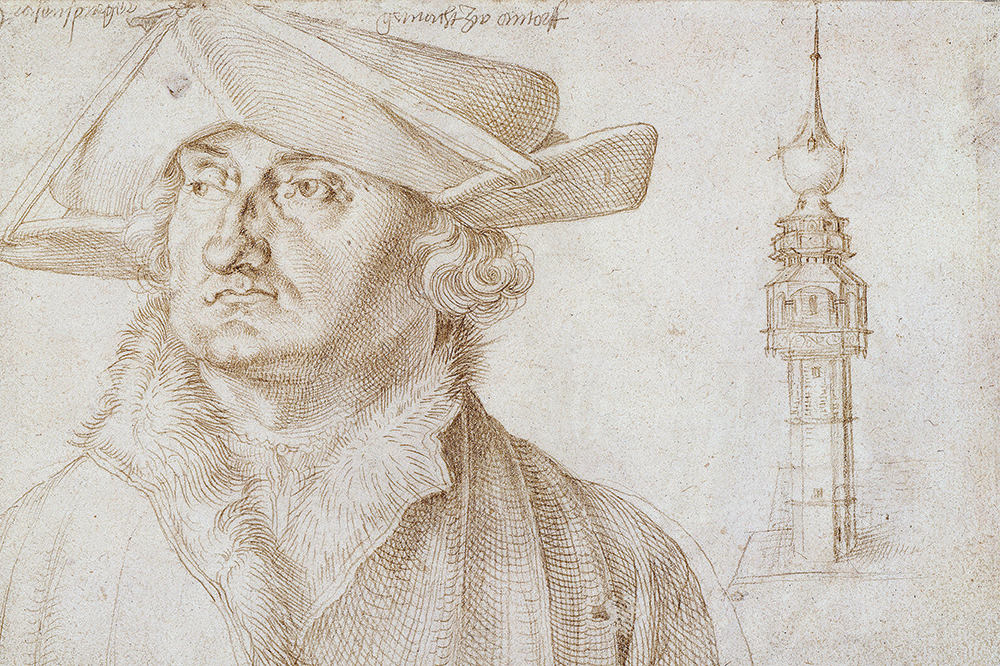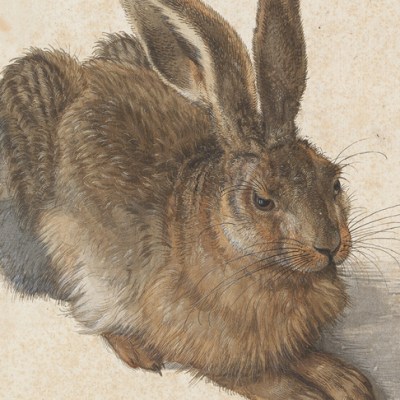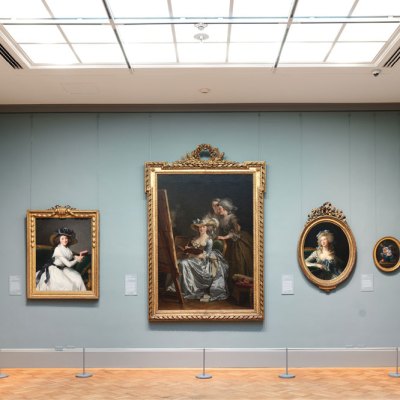From the January 2022 issue of Apollo. Preview and subscribe here.
In 1520, Albrecht Dürer set out on a year of wandering and wonder. Hoping to secure the renewal of a pension that had lapsed on the death of the Holy Roman Emperor Maximilian I, he and his household left his native Nuremberg on 12 July for the Netherlands, reaching Antwerp on 2 August. The trading city would be his base for the subsequent year, but Dürer was far from settled, undertaking frequent trips, journeys full of risk and opportunity. In December 1520, he was almost shipwrecked en route to Zeeland in ultimately frustrated hopes of seeing a beached whale.
Dürer was as avid for curious sights and experience as for patronage. He brought with him prints and skills that he exchanged not only for money, but for exotic objects: sharkfins, coral, capers, tulip bulbs. In Brussels in 1521, Dürer saw Aztec marvels brought back from the New World: ‘spectacular things’ of gold, obsidian mirrors, ‘amazing’ shields fledged in feathers. His journey led him to the edge of Europe, and the heart of an expanded world.
Dürer’s journeys are the subject of this exhibition, and of its sumptuously illustrated catalogue containing 15 essays on aspects of Dürer’s itinerary and itineracy. The exhibition is a collaboration between the National Gallery and the Suermondt-Ludwig-Museum in Aachen, where a smaller show focused on the 500th anniversary of the coronation of Charles V, Maximilian’s successor, and Dürer’s visit there. In London, attention widens to take in Dürer’s apprentice Wanderjahre in Swiss and German towns in the early 1490s, and his southward journeys to Italy in the subsequent decade. The expansion of scope also invites contemplation of travel and journeying in Dürer’s work more broadly – whether in terms of the widespread distribution of his prints, the migration of his motifs to Italian and Dutch artists, or images of journeying itself.
Lazarus Ravensburger and the Tower of the House of Mayor Arnold van Liere in Antwerp (recto) (1520–21), Albrecht Dürer. Staatliche Museen zu Berlin, Kupferstichkabinett. Photo: Jörg P. Anders; © Photo Scala, Florence/bpk, Bildagentur für Kunst, Kultur und Geschichte, Berlin

The exhibition is nonetheless at its most successful in its display of Dürer’s time in the Netherlands – the earlier rooms on the Swiss, German and Italian contexts seem diffuse and unfocused in comparison, though they contain much wonderful Dürer. The contrast arises in part because of the extraordinary boon of surviving documentation relating to the journey of 1520–21. Two later copies, and one original sheet, of Dürer’s own journal have survived. Several sheets from the so-called ‘silverpoint sketchbook’, in which Dürer drew people, animals, objects and buildings he encountered en route, are also extant, if dispersed. The opportunity to see several of these fugitive pieces reconvened in a single space is one of the exhibition’s great attractions, despite their small size and relative lack of finish. They allow us to catch Dürer on the move and see what caught his eye, in studies that range from the quotidian – a chest, a table, some jugs – to the strange: lions and exotic animals, regional costumes, idiosyncratic faces. The catalogue’s reproduction of all the surviving pages of the silverpoint sketchbook, discussed in Arnold Nesselrath’s meticulous essay, gives a richer sense of the range of Dürer’s attention, but doesn’t allow the same sense of intimacy with the small pages and detailed stylus marks, each the trace of a minute act of noticing, that the exhibition permits.
Similarly evocative are the ephemeral drawings undertaken during the journey, including multiple examples of a genre of large-scale portrait drawing that Dürer pioneered. Quick to produce (as Peter van den Brink’s interesting catalogue essay shows, Dürer could draw as many as three in an evening), these were put to multiple purposes: used as payment or gift, sold for cash or exchanged for artefacts, or kept as studies of form for his own purposes. All of them speak of the network of acquaintance, sociability, and commerce that Dürer established in the Low Countries. Like the sketchbook drawings, they are momentary rather than monumental. Unlike the painted likenesses elsewhere in the exhibition, Dürer’s quick portraits sacrifice the fastidious representation of cloth, fur and surface – one of the exquisite pleasures of his paintings or engravings – for a sense of speed that makes them the record of his ingenious hand and eye in the capture of an instant. The jut of a jaw or the arc of an eyebrow lodge character in a single point of particular intensity. A beautiful drawing of Katharina, the young black servant of the Portuguese merchant João Brandão, which Dürer kept for himself, shows her with the downcast eyes and set of mouth which also mark his chalk portrait of Erasmus (not shown in this exhibition), or his Portrait of a 39-Year-Old Woman: a sympathetic sign of absorption, inwardness, and melancholy.
Nine Studies of Saint Christopher (1521), Albrecht Dürer. Staatliche Museen zu Berlin, Kupferstichkabinett. Photo: Jörg P. Anders; © Photo Scala, Florence/bpk, Bildagentur für Kunst, Kultur und Geschichte, Berlin

Speed is also characteristic of another astonishing item in the exhibition: nine black ink drawings on a single sheet of paper of Saint Christopher carrying the Christ Child. They were probably intended as a gift for Joachim Patinir, a Flemish landscape painter, whose wedding Dürer attended in May 1521. Saint Christopher is patron saint of travellers, ferrymen and mariners, and since Dürer had recently decided to return home, the drawings might also be seen as a personal act of invocation. The saint is bent under the unexpectedly heavy weight of a child who is also the whole world and its maker. He strives against the current, counterpoises his weight on his stick, and battles the buffeting wind. But the drawings themselves speak not of slow labour but of velocity, and resourcefulness of invention. Dürer’s hatching is quick. Christopher’s cloak is tugged into strange dynamic billows. The image on the bottom right is so lightly sketched as to seem blown rather than drawn across the paper. Together, the varied postures of the saint – one foot lifted out of the water, casting his cloak over his shoulder, using both hands to drive himself with his stick – even anticipate cinematic stills, frozen moments from a scene of movement.
The studies of Saint Christopher, and a related painting by Patinir, are key to the most stimulating essay in the catalogue: Joseph Leo Koerner’s ‘Dürer in Motion’, which argues that ‘flux is Dürer’s element’. While the other contributions mount original scholarly arguments about the contexts of various works, Koerner interweaves Dürer’s own journeys with other senses of movement which animated him, such as global commerce, the portability of print and paper, the articulation of joints, and the mobile mind characteristic of the ingenious craftsman. The exhibition, with its rather perfunctory captions, would have benefitted from inviting the visitor more explicitly towards this manifold interest in motion: Koerner’s essay allows glimpses of a stranger, more curious Dürer, restless, wandering, moving at speed.
‘Dürer’s Journeys: Travels of a Renaissance Artist’ is at the National Gallery, London, until 27 February.
From the January 2022 issue of Apollo. Preview and subscribe here.



